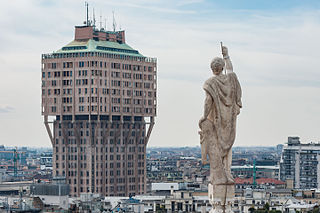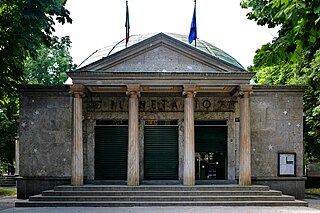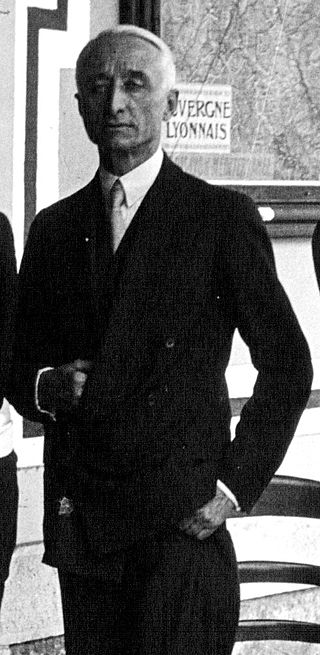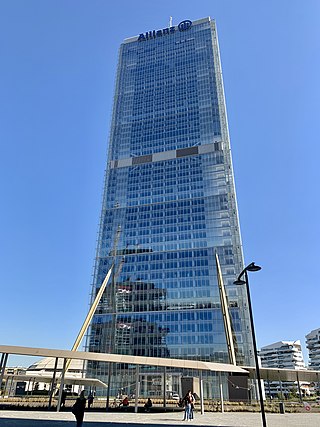
The Castello Sforzesco is a medieval fortification located in Milan, Northern Italy. It was built in the 15th century by Francesco Sforza, Duke of Milan, on the remnants of a 14th-century fortification. Later renovated and enlarged, in the 16th and 17th centuries it was one of the largest citadels in Europe. Extensively rebuilt by Luca Beltrami in 1891–1905, it now houses several of the city's museums and art collections.

Rozzano is a comune (municipality) in the Metropolitan City of Milan, in the Italian region Lombardy, located about 9 kilometres (6 mi) south of Milan.

The Torre Velasca is a skyscraper built in the 1950s by the BBPR architectural partnership, in Milan, Italy. The tower is part of the first generation of Italian modern architecture, while still being part of the Milanese context in which it was born, to which also belongs the Milan Cathedral and the Sforza Castle.

Piazza San Babila is a city square in Milan, Italy.

SNIA S.p.A. was an Italian firm located in Milan that manufactured defence products, textiles, chemicals, perfumes, and corrugated paper among other products.

The Milan Planetarium is the largest and most important planetarium in Italy. It is located in the Gardens of Porta Venezia, in the Porta Venezia district of Milan. It was established in 1930, and has been in operation since then.

The Palazzo del Credito Italiano is a historic building situated in Piazza Cordusio in Milan, Italy.

Riccardo Gualino was an Italian business magnate and art collector. He was also a patron and an important film producer. His first business empire was based on lumber from Eastern Europe and included forest concessions, lumber mills, ships and warehouses. The highly leveraged structure collapsed in 1912–13. Gualino was also involved in manufacturing and distributing cement, and during World War I (1914–18) built and operated cargo ships carrying goods such as coal from the United States to Europe. After the war he was engaged in many enterprises, some in partnership with Giovanni Agnelli of FIAT. His activities included banking, manufacture of rayon, confectionery, chemicals and artificial leather.

Allianz Tower, also known as Isozaki Tower, is a fifty-floor, 209-metre-tall (686 ft) skyscraper in Milan, Italy. Designed by Japanese architect Arata Isozaki and Italian architect Andrea Maffei, it serves as the headquarters of the Italian subsidiary Allianz SpA.

Porta Torre is a main fortified tower located in the town of Como, in Lombardy. It is 40 meters high and it was built in 1192, to defend the main entrance of the city.

The Arese are a prominent family of the Milanese nobility.

The Visconti Castle of Legnano is a mediaeval castle, located south of the city of Legnano, Metropolitan City of Milan, Lombardy, northern Italy. It lies on a small island formed by the Olona river. Since the 13th century, it is also known as the castle of San Giorgio.

Tiburtino is the 6th quartiere of Rome (Italy), identified by the initials Q. VI. The name derives from the ancient road Via Tiburtina. It belongs to the Municipio II, Municipio IV and Municipio V.

The Galleria del Corso is a major shopping arcade in the historic center of Milan, Italy, one of five built in the city in the interwar period (1919–39), along with the Galleria del Toro, Galleria Mazzini, Galleria Meravigli and the Galleria Gonzaga.

Characteristic of the historic center of Pavia is the presence of medieval noble towers that survive in its urban fabric, despite having once been more numerous, as evidenced by the sixteenth-century representation of the city frescoed in the church of San Teodoro. They were mostly built between the 11th and 13th centuries when the Ghibelline city was at the height of its Romanesque flowering.

The monastery of Santa Maria Teodote, also known as Santa Maria della Pusterla, was one of the oldest and most important female monasteries in Pavia, Lombardy, now Italy. Founded in the seventh century, it stood in the place where the diocesan seminary is located and was suppressed in the eighteenth century.

















